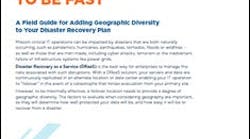Far Enough to be Safe, Close Enough to be Fast: A Field Guide for Adding Geographic Diversity to Your Disaster Recovery Plan
Mission-critical IT operations can be impacted by disasters that are both naturally occurring, such as pandemics, hurricanes, earthquakes, tornados, floods or wildfires – as well as those that are man-made, including cyber attacks, terrorism or the inadvertent failure of infrastructure systems like power grids. Disaster recovery capabilities are key to success.
Disaster Recovery as a Service (DRaaS) is one way for enterprises to manage the risks associated with such disruptions. With a DRaaS solution, your servers and data are continuously replicated in an alternate location or data center enabling your IT operation to “failover” in the event of a catastrophe that forces evacuation from your primary site.
However, to be maximally effective, a failover location needs to provide a degree of geographic diversity. The factors to evaluate when considering geography are important, as they will determine how well-protected your data will be, and how easy it will be to recover from a disaster.
Physical distance is one of the first considerations in designing or selecting a disaster recovery solution. How far away should the failover facility be from your production site? The general rule of thumb is that the recovery site should be “far enough away to be safe” – that is, it will not be subject to the majorityof the same risks as your primary site. Get the full report to learn more.
